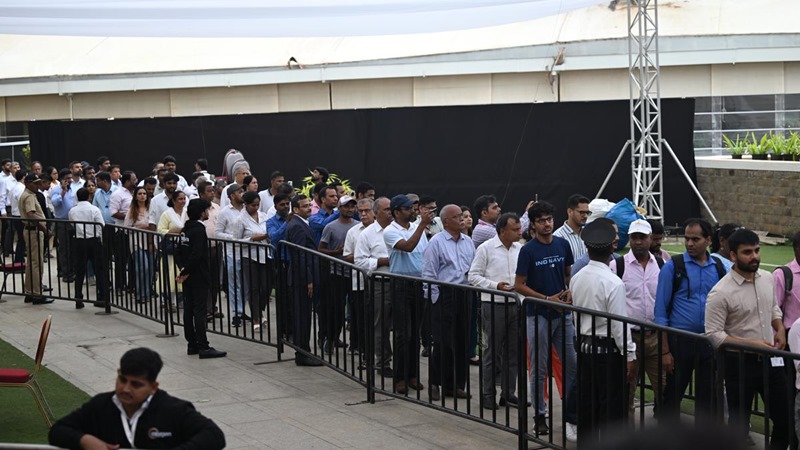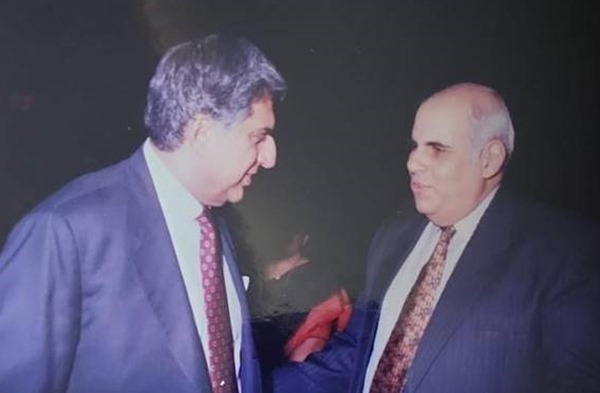The Tatas gifted Mumbai this sprawling cultural space with five theatres, an art gallery and a library.
On October 10, when the hearse carrying iconic industrialist Ratan Tata’s mortal remains drove into the National Centre for the Performing Arts (NCPA) for people to pay their final respects, not many would have realised India’s much-respected corporate house’s deep-rooted connect with culture, specifically NCPA.
Article by Chitra Swaminathan | The Hindu
People waiting to pay homage to Ratan Tata at NCPA lawns | Photo Credit: EMMANUAL YOGINI
The National Centre for the Performing Arts in Mumbai | Photo Credit: Courtesy: NCPA
Located at the end of Marine Drive by the Arabian Sea in the once-thriving business district Nariman Point (till Bandra Kurla Complex was developed), NCPA, a sprawling centre for performing arts in Mumbai, owes its existence to two visionaries — JRD Tata and Jamshed Bhabha (brother of nuclear physicist Homi Bhabha, who spent 60 years with the Tata Group).
Ratan Tata and NCPA chairman Khushroo N Suntook | Photo Credit: Special Arrangement
They worked together on several projects, the most significant being NCPA. Both were keen to have a world-class, comprehensive centre for the arts in Mumbai. They established NCPA in 1969 as South Asia’s first multi-venue and multi-genre cultural centre.
“Jamshed Bhabha met Mrs. Indira Gandhi when she was the Prime Minister, with a request to grant eight acres of land. She asked the then Chief Minister of Maharashtra Vasantrao Naik to help. When Bhabha approached him, the Chief Minister pointed towards the sea and told him this is the space available,” says NCPA chairman Khushroo N Suntook, with a chuckle.
The construction site after land was reclaimed from the sea | Photo Credit: Courtesy: NCPA
“Bhabha and JRD were fine with the offer. The Tatas spent more than eight years filling the land reclaimed from the sea,” adds Suntook.
Even while the work was going on, Jamshed Bhabha didn’t want to delay this dream project and set up NCPA in one of the floors of the high-rise building, Akash Ganga, which came up where eminent lawyer Bhulabhai Desai’s bungalow once stood.
“Despite initial challenges, the project took shape because of JRD’s total support,” elaborates Suntook. A colleague of Ratan Tata for many years, Suntook has served in various senior capacities in the Tata Group. His love for music led him to launch the Symphony Orchestra of India in 2006.
“The first theatre that came up at NCPA was called the Tata Theatre. Tata Consulting Engineers lent its technical expertise to come up with a revolving stage, a foyer and brilliant acoustics. Internationally-renowned architect Phillip Johnson and acoustic consultant Cyril Harris were roped in. Before work began, Bhabha visited many concert halls in the West. Eminent international and national artistes have performed here,” says Suntook.
Tata Theatre at NCPA | Photo Credit: Courtesy: NCPA
To mark its platinum jubilee, The Tata Iron and Steel Company came up with the Tata Experimental Theatre, which was designed as a Black Box — a simple performance space with black or grey walls and movable seating arrangement for a closer interaction with the audience.
Realising the need for a space to stage operas, musicals and full-fledged orchestras, NCPA inaugurated the Jamshed Bhabha Theatre on November 24, 1999. The theatre, which can seat 1,109 people boasts of a grand 100-year-old marble staircase donated by Sir Dinshaw Petit.
The historic marble staircase at Jamshed Bhabha Theatre | Photo Credit: Courtesy: NCPA
Recalling the making of this theatre, Suntook says: “Two months before its completion, almost the entire structure was gutted in a fire. Jamshed Bhabha was distressed, but made sure nobody indulged in any blame game. In less than two years, the theatre was again ready for inauguration. A modest man, he wanted to call it the National Theatre. But close friends and colleagues prevailed upon him, saying it is his baby and should carry his name.”
Ratan Tata with his friend and maestro Zubin Mehta | Photo Credit: Special Arrangement
Right from the time when Jamshed Bhabha proposed the creation of a cultural complex to Sir Dorabji Tata Trust, JRD Tata backed the idea wholeheartedly. Though some trustees were sceptical, in his letter to the Trust in 1965, Jamshed Bhabha wrote, “…Music and related arts constituted a most important part of the country’s 5,000-year-old cultural and spiritual legacy. Music accompanied an Indian from the cradle to the grave; from birth to death.” Not surprisingly, the Trust made an endowment of Rs 40 lakh to build the National Centre for the Performing Arts.
“Ratan continued the legacy with his unstinted support. He would attend western classical music concerts. He enjoyed listening to the works of Beethoven, Mozart and Brahms. Ratan, Zubin and I shared a warm relationship. When Zubin was here this September to perform with the Symphony Orchestra of India, Ratan wrote to me saying he is unable to make it to the concert because of his health condition. An astute businessman, a connoisseur of art and a kind-hearted soul, he created loyalties that were amazing. The huge crowd that came to bid him adieu proved it,” says Suntook.



